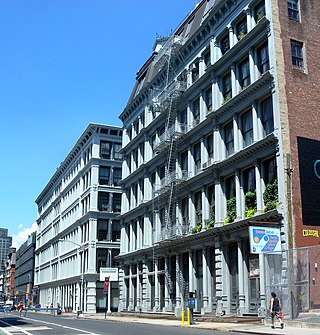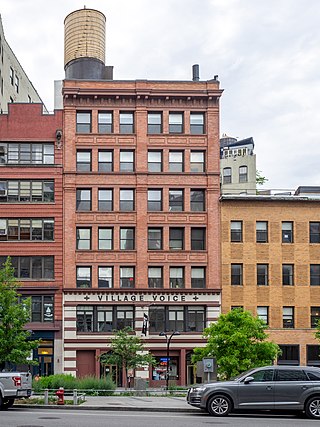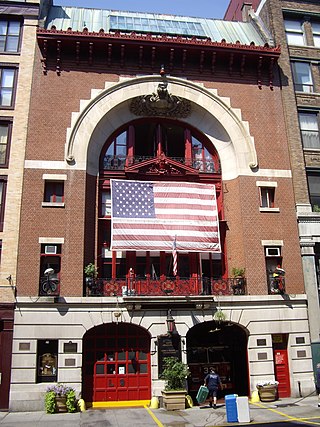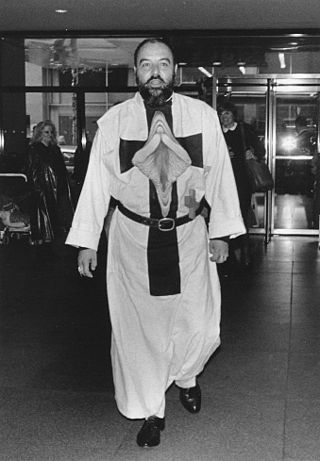
SoHo, sometimes written Soho, is a neighborhood in Lower Manhattan, New York City. Since the 1970s, the neighborhood has been the location of many artists' lofts and art galleries, and has also been known for its variety of shops ranging from trendy upscale boutiques to national and international chain store outlets. The area's history is an archetypal example of inner-city regeneration and gentrification, encompassing socioeconomic, cultural, political, and architectural developments.

The Village Voice is an American news and culture publication based in Greenwich Village, New York City, known for being the country's first alternative newsweekly. Founded in 1955 by Dan Wolf, Ed Fancher, John Wilcock, and Norman Mailer, the Voice began as a platform for the creative community of New York City. It ceased publication in 2017, although its online archives remained accessible. After an ownership change, the Voice reappeared in print as a quarterly in April 2021.

NoHo, short for North of Houston Street, is a primarily residential neighborhood in Lower Manhattan in the New York City borough of Manhattan. It is bounded by Mercer Street to the west and the Bowery to the east, and from East 9th Street in the north to East Houston Street in the south.

Tribeca, originally written as TriBeCa, is a neighborhood in Lower Manhattan in New York City. Its name is a syllabic abbreviation of "Triangle Below Canal Street". The "triangle" is bounded by Canal Street, West Street, Broadway, and Chambers Street. By the 2010s, a common marketing tactic was to extend Tribeca's southern boundary to either Vesey or Murray Streets to increase the appeal of property listings.

Great Jones Street is a street in New York City's NoHo district in Manhattan, essentially another name for 3rd Street between Broadway and the Bowery.

The Bayard–Condict Building is a 12-story commercial structure at 65 Bleecker Street in the NoHo neighborhood of Manhattan in New York City. Built between 1897 and 1899 in the Chicago School style, it was the only building in New York City designed by architect Louis Sullivan, who worked on the project alongside Lyndon P. Smith. Located in the NoHo Historic District, the building was designated a New York City landmark in 1975 and has been a National Historic Landmark since 1976.
Brooklyn Paper is a weekly newspaper that covers news related exclusively to the New York City borough of Brooklyn. Brooklyn Paper covers news and cultural events throughout the borough, using different mastheads for neighborhoods such as Park Slope, Brooklyn Heights, Bay Ridge, etc. In addition to news coverage, the paper also publishes a weekly entertainment guide entitled GO Brooklyn. It was founded in 1978.

Margot McCoy Gayle was an American historic preservationist, activist, and writer. She led the effort to designate the SoHo Cast Iron Historic District, which preserved Victorian era cast-iron architecture in New York City.
Peter Solomon Frank is an American art critic, curator, and poet who lives and works in Los Angeles. Frank is known for curating shows at the Solomon R. Guggenheim Museum in the 1970s and 1980s. He has worked curatorially for Documenta, the Venice Biennale, Museo Nacional Centro de Arte Reina Sofía, and many other national and international venues.

Industry City is a historic intermodal shipping, warehousing, and manufacturing complex on the Upper New York Bay waterfront in the Sunset Park neighborhood of Brooklyn, New York City. The northern portion, commonly called "Industry City" on its own, hosts commercial light manufacturing tenants across 6,000,000 square feet (560,000 m2) of space between 32nd and 41st Streets, and is operated by a private consortium. The southern portion, known as "Bush Terminal", is located between 40th and 51st Streets and is operated by the New York City Economic Development Corporation (NYCEDC) as a garment manufacturing complex.

Village Preservation is a nonprofit organization that advocates for the architectural preservation and cultural preservation in several neighborhoods of Lower Manhattan in New York City. Founded in 1980, it has advocated for New York City designated landmark status for a variety of sites like the Stonewall Inn and Webster Hall. The organization and its Executive Director, Andrew Berman, have been described as influential in New York real estate, while some of its activities to prevent development and to support restrictive zoning have attracted criticism.

Ted Stamm (1944-1984) was an American minimalist and conceptualist artist.
John Lucas Perreault was a poet, art curator, art critic and artist.

René Moncada is a South American-born artist living in the United States of America. He is best known for a series of murals undertaken in New York City's SoHo neighborhood between the late-1970s to early-1990s which spelled out the proclamation I AM THE BEST ARTIST René. He is also separately known for controversial artwork such as Sex and Violence, which depicts a cross with a vagina at its center, and as an outspoken opponent of censorship in the arts. His art was known to be sexually suggestive which made René an occasional target of anti-pornographic groups over the years as seen with the Mott's Apple Juice piece.
Holly Solomon Gallery opened in New York City in 1975 at 392 West Broadway in Soho, Manhattan. Started by Holly Solomon - aspiring actress, style-icon, and collector - and her husband Horace Solomon, the gallery was initially known for launching major art careers and nurturing the artistic movement known as Pattern and Decoration, which was a reaction to the austerities of Minimal art.
Michael Goldstein was an American music publicist and journalist who was the founder of the SoHo Weekly News, an alternative newspaper published in New York City from 1973 to 1982. Prior to starting the paper, he worked in public relations. As a music publicist, his clients included Jimi Hendrix, Sly Stone, Rod Stewart, Eric Clapton, Janis Joplin, Frank Zappa, Jefferson Airplane, and the Grateful Dead.
Raphael De Niro is an American real estate broker and former actor. He often works with celebrity clients, including Jon Bon Jovi, Renée Zellweger, Travis Kalanick and Kelly Ripa. De Niro is the son of actor Robert De Niro and actress Diahnne Abbott. He has also appeared in several films: Love Streams (1984); West 4th (2007); James Abbott is Gone (2013); Raging Bull (1980); and Awakenings (1990). De Niro is a broker for Douglas Elliman, and was ranked first in The Real Deal's Manhattan top residential agents in 2017.

Kim Hastreiter is an American journalist, editor, publisher, and curator who co-founded Paper magazine. She served as co-editor-in-chief from its inception until 2017, when she and partner David Hershkovits sold the company. In her column of 32 years, "Note From Kim", Hastreiter observed and articulated cultural movements and trends that she saw forming, deciphering the transforming zeitgeist. She currently resides in Greenwich Village, New York City.
Sam Dolnick is an American journalist, film and television producer, and assistant managing editor for The New York Times. He helped launch The Daily podcast and the documentary series, The Weekly.

The SoHo Memory Project is a nonprofit organization that celebrates the history of SoHo with a focus on the years 1960–1980, when it was a thriving artists’ community. It chronicles the neighborhood's evolution, charting cycles of development and placing current-day SoHo in the context of New York City's history. Its aim in preserving the past is to help the present generation make informed decisions about the future.














